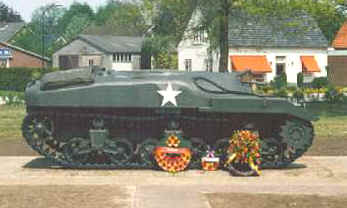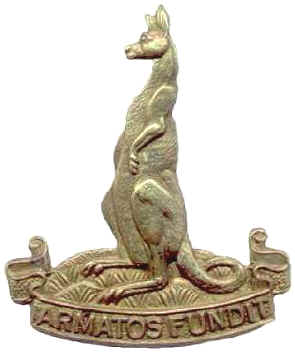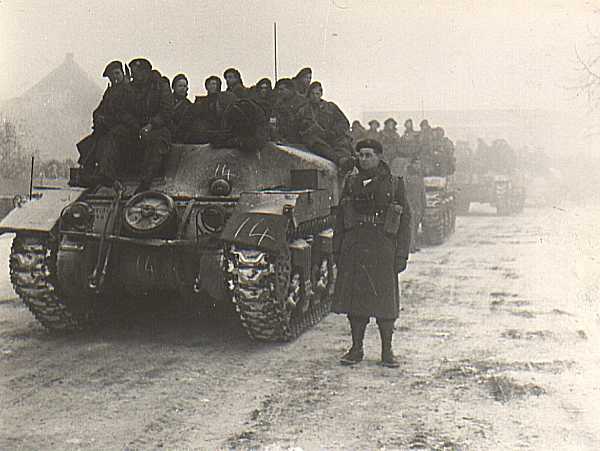 |
| Category:
Armour/Allied WW2 |

|
|
|
|
|
|
The Canadian
Kangaroos in WW2 |
|
1st Canadian
Armoured (Personnel) Carrier Regiment |
 |
ARMATOS FUNDIT,
loosely translates to
Bearing Armed Men |
 |
 |
| Ram Kangaroo |
Priest |
Other
Vehicles |
|
To quote
Ken Ramsden, in
THE
CANADIAN KANGAROOS IN WW2:
...Developing a strong unit
with high performance standards was not an easy task. With a suddenly
assembled strength of 268 all ranks, no regimental home in Canada, no
regimental traditions, and a group of newly-arrived officers, NCOs and
troopers, it was a challenge of considerable proportion.
Amongst the first on the list was
proper unit identity. Thus was born the classic 'Kangaroo' cap badge. As
a mother kangaroo protects and transports her young within her pouch, so
too did the Canadian Kangaroos for the infantry. The Regimental motto
was decreed as ARMATOS FUNDIT, loosely translated as
"Bearing Armed Men'. It was incorporated into a scroll on the
bottom of the badge. |
 |
 |
| The morning mists of mid-winter roll about
a column of loaded Kangaroos somewhere in Holland, January 1945. Note
that the troops in the lead vehicle are wearing berets, which suggests
this might be an administrative move rather than combat assault. The
gentleman on his feet looks like a cold and somewhat bored junior
infantry officer waiting for orders.
Kangaroo # 14 is a late-production model featuring a
hull-mounted Browning .30 calibre machine gun rather than the cupola of
the earlier Ram IIs. Most Kangaroos were initially equipped with at
least one Browning .50 on an improvised mount on the turret ring, but
these mounts were found awkward and unreliable due to the incredible
vibration of firing, and were subsequently replaced with one or two
additional Browning .30s scrounged from wrecked vehicles or wherever
they could be found.
Sticking with .30s also eased a logistical problem
in that much more of the smaller calibre ammunition could be carried,
and no space required for bulky .50 calibre. Generally, responsible
infantry were taught to man these extra guns on the run into the
debarkation point (it was easier to teach them to use the .30 as well),
providing saturating fire all over the objective. A troop of eight
Kangaroos would thus have a minimum of sixteen machine guns to cover
their advance, not including the Brens of their infantry lift and the
support from whatever other armour might be along for the ride.
The Kangaroo's worst enemies in 1945 were mines and
artillery. The former usually just blew off tracks and running gear (and
shaking up the occupants!), but the latter could prove deadly in or out
of the tank. Most Kangaroo casualties were as a result of artillery
fire. |
|
A Short History of
The Kangaroos |
 |
| The Kangaroo concept of
moving infantry units forward with the leading elements of armoured
formations quickly became a critical, integral aspect of armoured corps
operations in Northwest Europe, and later, in Italy. It is a concept
which remains the cornerstone of all infantry operations today.
The Canadian Armoured Corps, which
provided most of the personnel for the Kangaroos as well as the basis
for their administration and employment, was itself a relatively new
service, having only been constituted just a few short years before.
Largely through the efforts of one remarkable man, Frank
Worthington, Canada was able to field more than two complete armoured
divisions during WW2. They played a critical part in the campaigns in
Italy and Northwest Europe, fighting with equipment which was sometimes
greatly inferior to that of the enemy. The men of these units were
proud, bold, and creative, as they had to be - and they and their
attitudes were the seed corn of the startlingly simple, radical new
concept of carrying the infantry under armour (more may be read about
the Armoured Corps on the MAPLE
LEAF UP site).
The story of the Kangaroos is of a
unit which used what it could, wherever it could be found. The vehicle
chosen for their mission was initially the U.S. M7 Priest Self-propelled
Gun, which embodied a 105mm howitzer in an open body set on an early
Lee/Grant/Sherman chassis. As has been seen, in a momentous effort in
the first week in August 1944, 72 of these vehicles were overhauled and
modified as personnel carriers; subsequently they went on to prove a
concept which remains the cornerstone of infantry operations to this
day.
Once the inherent value of such a unit
was realized, and official steps taken to expand it into a full
regiment, the Priests, which were by this time some 53 in number through
battle damage and general mechanical attrition, were replaced by
specially modified Canadian Ram tanks, which were available in quantity
in depots in England (having been superceded as battle tanks by the U.S.
Sherman, itself having been declared the standard of Commonwealth
armoured formations).
Along with the new Regiment came a
significant headquarters infrastructure which also required different
vehicles for reconnaissance, logistics and general administrative
activities, which further changed the face of the unit as a whole.
|
| WITH THE
viability of the 'Unfrocked' Priests limited by battle attrition and
maintenance issues, a suitable supplement had to be found. It was
realized that there were in excess of 500 Canadian-manufactured Ram
tanks in storage in England; the Ram, being a predecessor to the U.S.
Sherman, had been designated obsolete for general armoured corps use,
due to design limitations imposed during the manufacturing process.
The Canadian Ram, manufactured by
Montreal Locomotive Works 1942-1943, was a unique Canadian design based
upon the chassis and power-plant of the American M-3 medium tank.
Designed originally for the obsolete British 2 pdr gun, it was later
adapted for the much better 6 pounder, but was incapable of taking the
75mm QF gun such as was retrofitted to the Churchill. As a result, the
Ram was replaced in combat units by the Sherman V, and used from then on
for training purposes only.
There was no question about converting
Shermans to APCs, as the battlefield attrition rate amongst those had
put severe strain on the replacement pipelines as it was, but the Rams
were another story. Here was a tank which would have been only
marginally successful in its original role as a cruiser tank, but which,
divested of its turret and inadequate main armament, was light, agile
and with a comparatively low profile.
The first Ram Kangaroos were delivered
to the Squadron at Pierreville, near Rouen, France, on 1 October 1944. At
the same time, discussions had been taking place at the higher echelons
about expanding the personnel carrier squadron. At this point, the
squadron was authorized four troops of 16 carriers each, along with 3 to
5 assigned to headquarters.
24 October 1944 marks the official birth
of the Regiment as an independent entity. On that day, an official
communication was received which indicated that
...By authority of the GOC 1st Canadian
Army, 19 October 1944, the 1st Canadian Armoured Personnel Carrier
Squadron ceased to exist as a separate entity and became a squadron of
the newly-created 1st Canadian Armoured Personnel Carrier Regiment.
The Regiment to be commanded by Lieut. Col. Gordon M. Churchill,
formerly 25th Canadian Armoured Delivery Regiment (Elgin Regiment) and
10 Canadian Armoured Regiment (Fort Garry Horse) with Major F.K.
Bingham Sherbrooke Fusiliers and 1st Hussars as Second-in-Command.
Regimental Headquarters to be at 83 van Ryswick St., Antwerp.
Lt. Col. Churchill was truly the right
man for the job. A Sergeant machine gunner in WW1, Churchill knew the
face of war. With the new regimental status, he was now able to indent
for the thousand-and-one things which the previous squadron had depended
on others for. At the same time, Col. Churchill set about creating the
trappings of a unique identity for this already unique unit.
Amongst the first on the list was
proper unit identity. Thus was born the classic 'Kangaroo' cap badge. As
a mother kangaroo protects and transports her young within her pouch, so
too did the Canadian Kangaroos for the infantry. The Regimental motto
was decreed as ARMATOS FUNDIT, loosely translated as
"Bearing Armed Men'. It was incorporated into a scroll on the
bottom of the badge. Shoulder titles for the new regiment were
manufactured locally, orange letters (representing Holland) "ARMD
CARRIER REGT Canada" embroidered on a black felt backing. The 1st
Canadian Armoured Carrier Regiment had come of age.
At this time, the Regiment also came
under command of 31 Brigade of the famous British 79th Armoured
Division. Previously, the association of the original squadron with the
British had been long and successful, and the whole concept of
specialized armour fit perfectly within the infrastructure of the
"Funnies" of this valourous assault division.
Accordingly, the Canadians of 1CACR
were authorized the wearing of the 79th 'Bullshead' flash, and the same
was painted on their vehicles, along with the unit designation
"157" in white on a green-and-blue square. On 1 November 1944,
RHQ moved formally to Tilburg, Holland, the 'birthplace' of the
Regiment. Luckily, deteriorating weather conditions - which were to lead
to the worst winter in Europe in 50 years - permitted the new CO to
concentrate on building the new organization.
|
| Fortunately, all progressed
smoothly. The new faces were integrated quickly, and through labourious
indents and some good, old-fashioned scrounging (for which the
Canadians in Europe were famous), the Regiment was brought quickly to a
state of battle readiness. At this point the combat strength of the
Regiment was 106 carriers, and it was contemplated increasing the two
existing squadrons to four, but this move was held in abeyance
indefinitely, due to the logistical difficulties.
By now, 1CACR also had a sister
regiment in the 79th Armoured Division, the British 49th Armoured
Personnel Carrier Regiment (also equipped with Ram Kangaroos), and it
was determined that, between the two, the assault requirements of 21st
Army Group would be satisfied. Towards the end of December, Col.
Churchill has also finally won the battle to have 1CACR formally known
as the '1st Canadian Armoured Carrier Regiment', dropping the word
'Personnel'.
This was significant, as elements
within the Canadian command infrastructure had long campaigned to make
1CACR a part of the Service Corps, due to its transport function; the
men of the Regiment were vociferously opposed to this categorization, as
in combat they were exposed daily to the same hazards as were the
infantry and armoured corps.
The Regiment was back in action in
January 1945, and stayed in the thick of things until the end of the
war. 'A' and 'B' Squadrons functioned pretty much independently from the
crossing of the Rhine until the official Cease Fire order on 5 May 1945,
causing no end of headaches to the administrative staff attempting to
keep up with the lads. However, both squadrons rendered yeoman service
to many British and Canadian infantry formations through this final
victory campaign.
Drawn from http://www.1cacr.org/
|
|